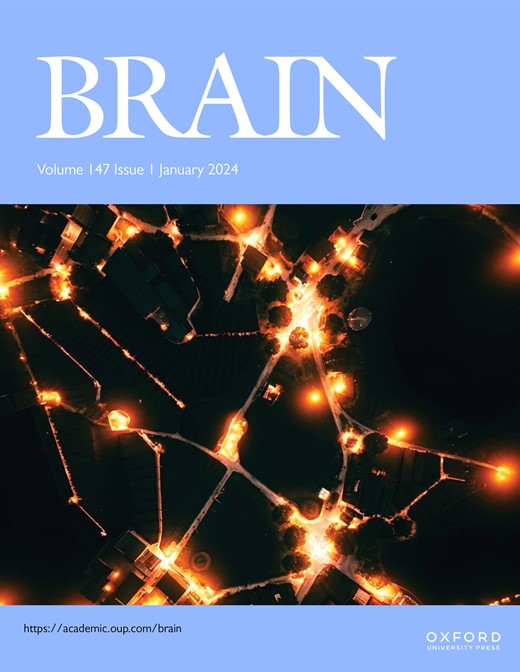Midbrain cytotoxic T cells as a distinct neuropathological feature of progressive supranuclear palsy
IF 10.6
1区 医学
Q1 CLINICAL NEUROLOGY
引用次数: 0
Abstract
Progressive supranuclear palsy (PSP) is a neurodegenerative disorder with 4-repeat (R) tau protein deposition. The substantia nigra (SN) and midbrain tegmentum nuclei (MBT) are consistently affected. Lymphocyte infiltrates are scarce in the brain of neurodegenerative diseases, although a few reports have described this feature in brains with the α-synucleinopathy, Parkinson’s disease (PD). To evaluate cytotoxic T-cell response, serial sections spanning 120 microns of the SN were consecutively immunostained for phosphorylated tau (AT8) or α-synuclein, cytotoxic T-cell marker, and microglia marker HLA-DR. Sections were analyzed with stereology software in 9 patients with PSP, 10 with PD, and 6 healthy controls. We semiquantitatively scored CD8-positive cells in further brain regions. CD8 lymphocyte cell counts, and microglial activation were increased in the SN of PSP compared to PD and controls. T-cell/neuron contact was observed in PSP. In multivariate models, CD8 counts were not predicted by disease duration, younger age at death, and by the amount of p-tau pathology. SN and midbrain tegmentum showed more CD8 cells than the cortex. The presence of more prominent nigral cytotoxic T-cell response in PSP than in PD supports the notion that the common p-tau neuropathology in PSP might have potential relationships with autoimmune mechanisms.中脑细胞毒性T细胞是进行性核上性麻痹的一个明显的神经病理特征
进行性核上性麻痹(PSP)是一种神经退行性疾病,伴有 4 重复(R)tau 蛋白沉积。黑质(SN)和中脑被盖核(MBT)始终受到影响。淋巴细胞浸润在神经退行性疾病的大脑中很少见,但有少数报告描述了α-突触核蛋白病--帕金森病(PD)大脑中的这一特征。为评估细胞毒性T细胞反应,对SN 120微米的连续切片连续进行磷酸化tau(AT8)或α-突触核蛋白、细胞毒性T细胞标记物和小胶质细胞标记物HLA-DR的免疫染色。我们用立体软件分析了9名PSP患者、10名PD患者和6名健康对照者的切片。我们对其他脑区的 CD8 阳性细胞进行了半定量评分。与帕金森病和对照组相比,帕金森病SN中的CD8淋巴细胞计数和小胶质细胞活化均有所增加。在 PSP 中观察到 T 细胞/神经元接触。在多变量模型中,CD8细胞数量不受病程、死亡年龄和p-tau病理程度的影响。与大脑皮层相比,黑质和中脑被盖区显示出更多的CD8细胞。与帕金森病相比,帕金森病患者黑质细胞毒性T细胞反应更为突出,这支持了一种观点,即帕金森病患者常见的p-tau神经病理学可能与自身免疫机制有潜在关系。
本文章由计算机程序翻译,如有差异,请以英文原文为准。
求助全文
约1分钟内获得全文
求助全文
来源期刊

Brain
医学-临床神经学
CiteScore
20.30
自引率
4.10%
发文量
458
审稿时长
3-6 weeks
期刊介绍:
Brain, a journal focused on clinical neurology and translational neuroscience, has been publishing landmark papers since 1878. The journal aims to expand its scope by including studies that shed light on disease mechanisms and conducting innovative clinical trials for brain disorders. With a wide range of topics covered, the Editorial Board represents the international readership and diverse coverage of the journal. Accepted articles are promptly posted online, typically within a few weeks of acceptance. As of 2022, Brain holds an impressive impact factor of 14.5, according to the Journal Citation Reports.
 求助内容:
求助内容: 应助结果提醒方式:
应助结果提醒方式:


